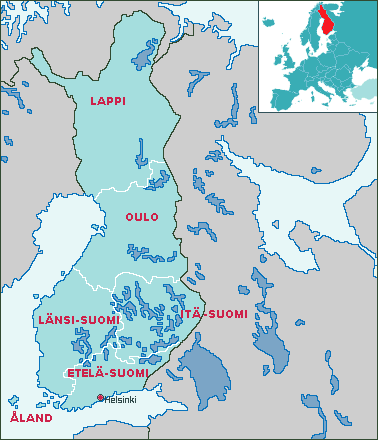Finland
An independent republic only since 1917, Finland was a Russian dominion from 1807 to 1917, before then was part of the Swedish kingdom, and in the course of history its identity was strongly influenced by its two powerful neighbours. The majority of the population is concentrated in the southern part, where the climate and enviroment are more favourable, in a triangle with Helsinki in the center, the textile town of Tampere, and the shipyarding town of Torku.
In short
Area: 338,145 km²
-- Population: about 5 million
-- Density: 17 per km²
-- Government: Parliamentary democracy
-- Capital: Helsinki
-- Language: Finnish, Swedish
-- Religion: Protestant
-- Currency: Euro
-- Telephone code: +358
-- International car plate: FIN
-- Internet suffix: .fi
-- Member of: the UNO since 1955, the EU since 1995

Administrative division
Finland is divided into 6 provinces (lääni), which are in turn furtherly subdivided into 20 regions (maakunta). The provinces are:
Southern Finland (Etelä-Suomi);
Western Finland (Länsi-Suomi);
Eastern Finland (Itä-Suomi);
Oulu (Oulu);
Lapland (Lappi);
Åland (Ahvenanmaan).
The climate
The climate is maritime to the west, more continental to the east. The summer lasts only 3 months, with average temperatures not exeeding 18 degrees C and the remaining nine winter months are very long and cold. The northern part, above the Artic Circle, is mostly desert.
History
In the 4th century A.D. populations coming from present-day Estonia founded some first settlements. Swedish peoples colonized the western part, while the northernmost territories were settled by Laponian populations. In 1939 Finland was occupied by the URRS, and was again independent only in 1945. In 1995 the Finland was admitted in the European Union.
Cities and places of interest
Helsinki, the capital and main city is situated in the south, on the tip of a small peninsula, well protected by a row of islands that enclose the harbor; the temperatures are quite cold, and in the winter some parts of the sea many freeze. Helsinki is the main port and industrial center of the country, and is a mainly modern town since fires in 1713 and 1808 almost destroyed the ancient architecture. The streets are wide and regular, and converge towards the Senate Square, which is located behind the harbor, and is the heart of the city, with the majestic Lutheran "Big Church", the University, the Government Palace. Great architects designed other imposing buildings as the railway station, a project by Eliel Saarinnen, and many private and public contructions designed by Alvar Aalto.
UNESCO World Heritage Sites

Fortress of Suomenlinna near Helsinki; Old Rauma, the wooden city centre of Rauma; Petäjävesi Old Church ; Verla Groundwood and Board Mill in Jaala; Bronze Age Burial Site of Sammallahdenmäki, in Lappi; Struve Geodetic Arc (2005) — shared with Belarus, Estonia, Latvia, Lithuania, Moldova, Norway, Sweden, the Russian Federation and Ukraine.
Natural Sites: High Coast and Kvarken Archipelago — transboundary property, shared with Sweden.
Natural Sites: High Coast and Kvarken Archipelago — transboundary property, shared with Sweden.
The Economy
Since a large part of the land is covered with forests, timber for construction and wood as fuel is the main resource and export merchandise. Thanks to the abundance of waters there are a great many sawmills which allowed the rise of a remakable tradition of furniture and design. Finnish designers are famous for their ability in merging simplicity,elegance and enviromental compliance.

